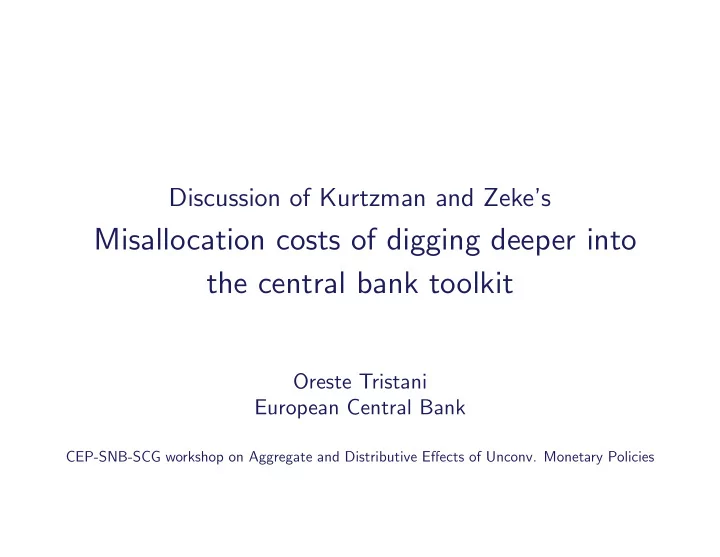

Discussion of Kurtzman and Zeke’s Misallocation costs of digging deeper into the central bank toolkit Oreste Tristani European Central Bank CEP-SNB-SCG workshop on Aggregate and Distributive Effects of Unconv. Monetary Policies
The paper in context • Plenty of central bank research on the potential benefits of QE. This paper digs deeper on their potential costs • Various criticisms have come up in the policy debate (risk of high inflation, of sawing the seeds of financial instability, ...). Focus here is on the category "market distortions" • Analysis centred on corporate bond purchases. Key lesson: caveat to the general principle of targeting relatively more im- paired assets
A topical paper! The ECB held just under EUR 90bn in corporate debt as of May and has faced accusations of withholding important information about the purchases. While the purchases are a small amount of the EUR 1.9tn the bank has spent on QE, they have been among the most controversial aspects of the programme. More than 40 MEPs have campaigned for the ECB and the NCBs to reveal the names of the companies benefiting from the purchases – to see whether certain companies or economic sectors are being favored. (FT June 21, 2017) Even supposedly market-neutral interventions by central banks may show an unintended structural bias towards carbon-intensive industry incumbents. [...] This paper argues that central banks should also consider how their opera- tion of monetary policy could affect the transition to a low-carbon economy . (Grantham Research Institute on Climate Change and the Environment, May 2017 Policy Brief on "The climate impact of quantitative easing")
An even simpler intuition I • Start from a frictionless economy with technology Y t = A t N t and perfect competition. Firms’ FOC: w t = A t • HH FOC − u N,t u C,t = w t • Benchmark − u N,t = A t u C,t
An even simpler intuition II • Assume firms must borrow to pay wages in advance (Correia, De Fiore, Teles, Tristani, 2016): A t = R l t R t w t • Equilibrium − u N,t R t = A t R l u C,t t ���� aggr. distortion • Credit policy should minimize R l t R t
Even simpler intuition III • Now introduce a second sector as in the paper � � 1 − ρ R t � Y 1 ,t � 1 − ρ R l − u N,t A 1 ,t Y m,t = ω 1 2 ,t = ρω j A j,t and R l R l u C,t Y j,t Y 2 ,t ω 2 A 2 ,t j,t 1 ,t � �� � � �� � aggr. misalloc. distortion distortion • Not optimal to minimise only 1 spread. • Buy low-risk gov’t bonds rather than medium-risk corp bonds
Remarks • Not an argument for inaction. In the paper, aggregate distor- tion is quantitatively more important, especially at the ZLB • Multi-sector models always generate implications for relative prices (e.g. Aoki, 2001). Charaterize optimality explicitly? • Or take a positive route. Two key implications from the model: spreads also fall, but less, in the sector whose bonds are not purchased; lending switches towards the sector whose bonds are purchased. Do these results match the available evidence?
CSPP evidence • CSPP: “Investment-grade euro-denominated bonds issued by non-bank corporations established in the euro area will be in- cluded in the list of assets eligible for regular purchases under a new corporate sector purchase programme ” (10 March 2016) • Arce, Gimeno and Mayordomo (BdE 2017): “Making room for the needy: credit-reallocation effects of the ECB’s Corporate QE” (see also Grosse-Rueschkamp, Steffen and Streitz, 2017) — Caveat: in the data, smaller firms have larger spreads, but they may reflect higher default risk
CSPP: spreads move as predicted by the model
CSPP evidence for Spain: lending flows • More complex story: — NFCs whose bonds are eligible for the programme increased issuance and reduced bank-lending by 20%; — banks experiencing such drop in credit increase lending to firms which do not issue corporate bonds (more than banks which did not lend to eligible NFCs)
Summary • A neat paper • Implications are policy relevant • The authors may want to calibrate the model to the euro area experience with the CSPP
Recommend
More recommend